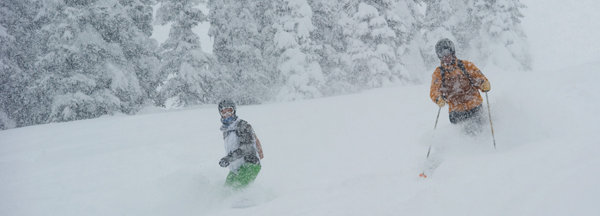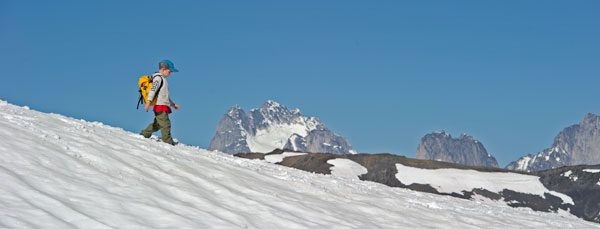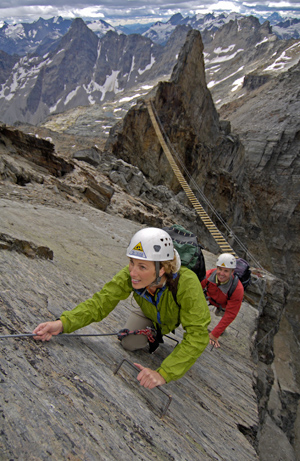Lift lines and ski bars the world over have witnessed the soft vs. hard shell debate; however, like the snowboard vs. ski debate, the best answer is probably a resounding: both. Waterproof breathable fabrics are better than they have ever been, but even the best gets wet inside if you are pushing it aerobically. A soft shell will become a frozen mold of your body in wet, near-freezing conditions like these at CMH Revelstoke:
For the opinion of someone who spends most of her winter days in the snow, I caught mountain guide Lilla Molnar during a week off – on a ski tour in Whistler, British Columbia – between shifts heli-ski guiding at CMH Bugaboos.
TD: Can you explain what happens to soft shells during multi-day outings in wet/cold environments?
LM: Wet and cold is not so bad but wet and warm is when the fabric starts to absorb water.
TD: So then is old-fashioned hard shell outerwear still better?
LM: On wet days. Either in rain or wet snow, when the freezing level is right around zero. A Gore-Tex shell is a key piece of equipment in coastal snowstorms – which I am now experiencing here in Whistler. Even Gore-tex eventually gets wet, but then it dries faster than soft shell with body heat and or wind.
TD: So what is the ideal environment/trip for soft shells?
LM: A ski touring trip in the interior ranges of British Columbia or the Rockies is the ideal environment. Ski touring is as much about the uphill as it is about the downhill. It is an aerobic sport and sweating is inevitable.
- Soft shells breathe well while you work hard going uphill – so that you are not too sweaty and cold when it comes to the downhill.
- Soft shells shed snow in a cold environment as long as temperatures are well below freezing.
- Soft-shells are quite wind resistant, and I find when the wind is blowing it helps to disperse the moisture which is accumulating on the jacket from outside moisture and also perspiration.
- Soft shells have a nice feel and move well with your body. It is generally quite soft, pliable and not as noisy as Gore-Tex.
TD: So what do you recommend people bring for outerwear on multi-day ski tours?
LM:
- Start with a good base layer; a wool blend is good for those who don’t sweat too much, polypro (or a similar synthetic material) works better for heavy sweaters.
- A soft shell layer should go above this.
- A lightweight hard shell can be stowed in your bag skinning up, and thrown on for shedding face shots on the descent.
- A light down or synthetic insulated jacket should also be packed. Who knows what the day brings…
TD: Would you use soft shell on a ski tour without a hut or lodge to dry out in?
LM: I would only use soft shell on that kind of a ski tour if I anticipated that the conditions would be fairly dry. Generally, I would take a soft shell on the trip but would have a Gore-Tex along, no matter what, in case of nasty weather.
TD: What about hard vs soft shells while helicopter snowboarding and skiing?
LM: Definitely hard shell. Generally, heliskiing is very snowy. Seems obvious, but what I mean is that your clothing is constantly touching snow in one way or another. More so than with ski touring. In a heliskiing environment the snow is either falling from the sky, billowing up against your chest or being blown around by the helicopter. Another reality is that inevitably you will be digging yourself out of the snow after a good wipeout. Inside the helicopter, the snow will melt on your clothing and turn to water. Heliskiing is more anaerobic than aerobic (for most people) therefore you are less likely to sweat as much as if you were ski touring. But, no matter what the ads say, if you over-dress and overheat you will get wet from the inside out . On a deep powder day it is hard to stay dry, even with a brand new cutting-edge Arc’teryx shell, but you probably wont care.
Like the sound of pushing your equipment to the limit? Check out the world’s most diverse backcountry ski programs here.





Comments